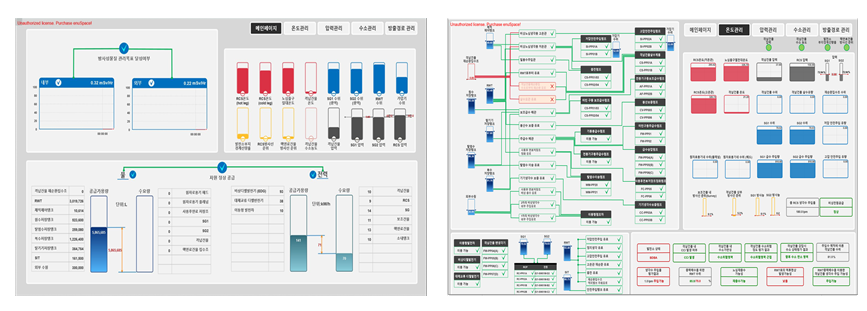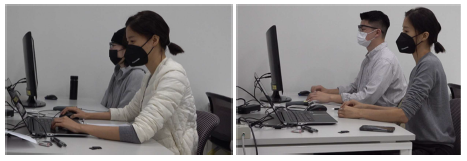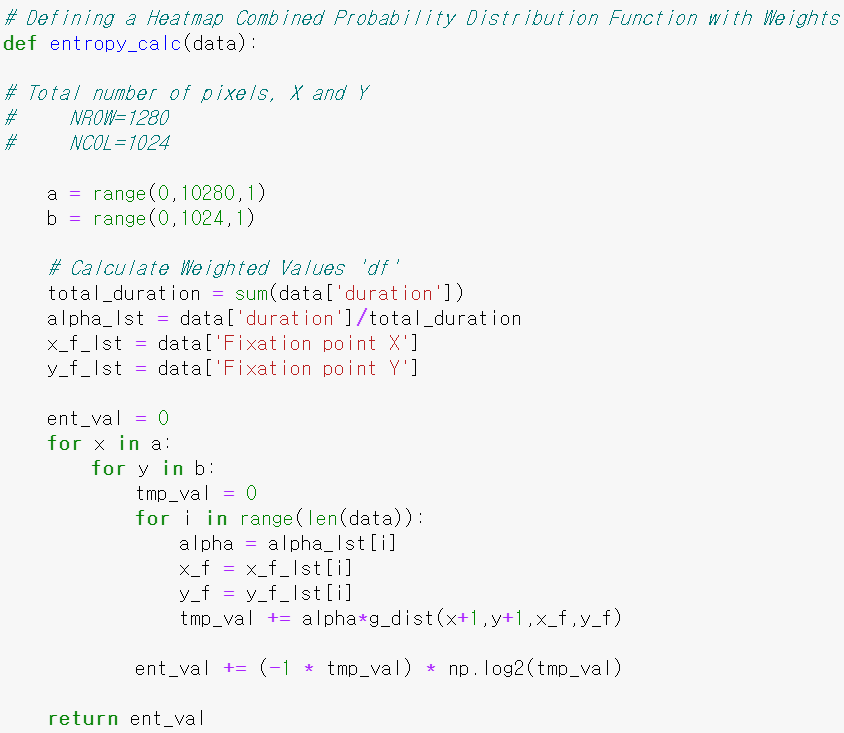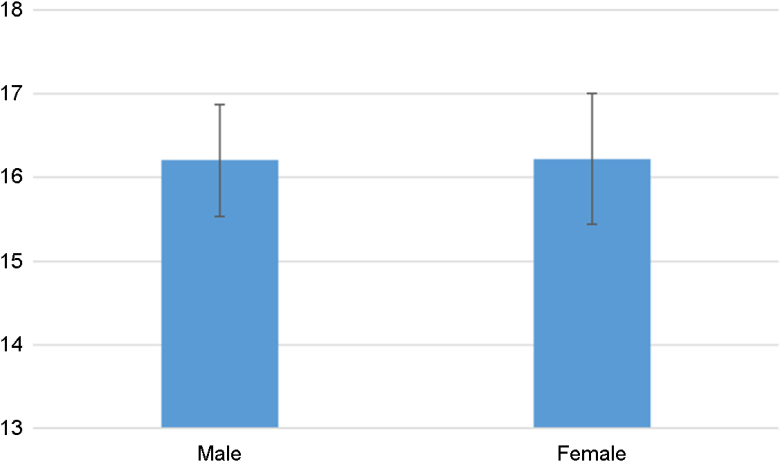eISSN: 2093-8462 http://jesk.or.kr
Open Access, Peer-reviewed

eISSN: 2093-8462 http://jesk.or.kr
Open Access, Peer-reviewed
Yejin Lee
, Pier Paolo Capestrani
, Kwang Tae Jung
, Hyun Chul Lee
10.5143/JESK.2023.42.4.323 Epub 2023 August 30
Abstract
Objective: The objective of this study is to identify the gender differences of judgment accuracy and time and gaze movement in the situation judgment task using the visual interface screen.
Background: Since humans receive more than 80% of their information through vision, the visual interface has been used as an important tool for providing information for situation judgment in the system. Due to the advancement of digital technology, humans often perform surveillance tasks in human-machine systems. Due to such changes in the work environment, the role of female workers in human-machine systems is increasing. Consequently, the comparative analysis of male and female task performance in the situation judgment task through the visual interface screen has an important meaning.
Method: The nuclear power plant accident response support system developed through the EID (Ecological Interface Design) method was used as a visual interface prototype. The problem of judging the situation was developed by considering the diversity of the task of judging the situation by looking at the visual interface screen. After formulating the problems, experimental scenarios that included each of these problem situations were developed. A total of 16 engineering students, eight males and eight females, participated in the experiment as subjects. The experiment was conducted in a quiet laboratory with participants wearing eye trackers. For the analysis of gaze movement, heat map entropy was utilized.
Results: The accuracy of judgment in the situation judgment task utilizing the visual interface screen was slightly higher in women than in men. However, the difference was not large. In addition, judgment time and heat map entropy in the situation judgment task did not show statistically significant differences according to gender.
Conclusion: These results suggest that there is no necessity to distinguish gender in situation judgment tasks in human-machine systems.
Application: The results of this study can be used as basic data to consider gender characteristics in visual interface design.
Keywords
Gender Situation judgment Situation judgment performance Heat map entropy
In a safety-critical system such as a nuclear power plant, it is important to correctly judge the state of the system. In a human-machine system, because humans receive more than 80% of their information through vision, the visual interface is an important component for conveying information related to task performance (Jeong and Lee, 2009; Lee et al., 2022).
In general, since there can be a significant difference in the task performance of men and women in situation judgment using visual information, it is important to conduct studies on this. In particular, its importance is increasing in light of the recent trend of increasing women's entry into industrial society. Looking at statistics on the female employment rate, since the 1990s, the number of female employees and participation in economic activities has increased significantly, and the employment rate of the entire female population in 2021 was 51.2%. This was a 3.4% increase from 47.8% in 2009. As the female employment rate continues to rise, the gap between male and female employment rates also continues to decrease, reaching 18.8% in 2021 (Cho et al., 2022).
Recently, due to the advancements in digital technology, work in large-scale human-machine systems has shifted to the form of monitoring tasks. Concurrently, the number of female workers in these large-scale systems is also increasing, in line with such changes in work types (Cho et al., 2022).
Differences in the task performance of women and men can often be seen, depending on the type of task. In particular, there are many cases in which task performance in physical task performance shows a remarkable difference, and many studies have been conducted on it. However, it is difficult to find studies on gender characteristics in repayment judgment tasks that use visual interfaces. Therefore, this study investigated the task performance of women and men in the situation judgment task within the human-machine system, as well as the gaze movement in the process, through experiments.
2.1 Experimental prototype
In this study, the nuclear power plant accident response support system developed through the EID (Ecological Interface Design) method was used as a visual interface prototype. EID is a design method to enable workers to solve problems more easily and quickly by visualizing the relationships between the constraints of the work domain and the various and complex information levels related to them in an easy-to-understand manner (Rasmussen and Vicente, 1990; Vicente and Rasmussen, 1992). As shown in Figure 1, the accident response system screen consists of five screens in two layers: the main screen and the lower screen.

2.2 Problem types and experiment scenarios
In this experiment, the problem of judging the situation was developed by considering the diversity of the task of judging the situation by looking at the visual interface screen. Three types of problems were developed. The first is a type of problem that observes changes in variables and judges their status (e.g., how does the value of the SG1 level change?). The second type of problem involves finding a variable that meets a specific condition (e.g., which power facility has the highest demand?). The third type of problem is to find a variable that shows a specific change, assuming a specific situation (for example, after a while, both demineralized water transfer pumps are stopped. In this case, which flow path becomes unavailable?). Eight problems, each of the same level, were developed for each problem type.
After formulating the problems, experimental scenarios that included each of these situations were developed. In this experiment, a total of five scenarios were developed and used according to the type of problem and the movement type of the variable. Five scenarios consist of three scenarios that included problem types 1 and 2 and two scenarios that included problem type 3. The experimental scenario was simulated to represent the state change of the power plant over 5min.
2.3 Experiment method
For the experiment, education and training were conducted for the subjects on the screen composition of the system and concept of variables. Overall, education and training on the experimental scenarios were conducted after understanding the composition of the screen and the concept of the variables. Ten problems were presented to the experimenter, and the experiment proceeded once the correct consecutive answers were given.
The subjects had to present their answers to problematic situations presented by the experimenter during the scenario process of the accident response support system.
A total of 16 engineering students, eight males and eight females, participated in the experiment as subjects. The experiment was conducted in a quiet laboratory with subjects wearing eye trackers, maintaining a distance of 60cm between the subject and the monitor. Figure 2 shows a scene in which the experiment is in progress.

3.1 The performance of situation judgment tasks according to gender
Task performance for the situation judgment task, as viewed on the visual interface screen, is usually represented by the accuracy and time of the judgment. Looking at the incorrect answer rate, which indicates the accuracy of situation judgment according to gender in Figure 3, males were 5.38% and females were 7.69%, showing a slightly higher incorrect answer rate.

As shown in Figure 4, which shows the judgment time of the situation judgment task according to gender, it can be seen that the difference between men and women is not large, and the difference is not statistically significant at the significance level of 0.05 (F=0.000, p=0.996). However, the data shows that the difference in judgment time is slightly larger in women. Therefore, the data suggests that the time required for situation judgment, utilizing information from the visual interface screen, is nearly the same for both genders.

3.2 Gaze movements according to gender
In this study, heat map entropy was used for the quantitative analysis of gaze movement. The quantification scale of gaze movement, utilizing the concept of entropy encompasses Shannon entropy, Markov entropy, dwell time entropy (based on the gaze duration or number of gazes on the Area of Interest (AOI), and heat map entropy (which considers the gaze intensity of the heat map) (Lee et al., 2020).
Since it is difficult to designate and analyze only specific components as AOIs in the accident response support system of the nuclear power plants used in this study, heat map entropy based on heat maps was used.
Assuming the heat map of the gaze distribution follows a Gaussian distribution, from the point with the longest to shortest gaze duration, Gaussian distribution can be applied to calculate the heat map entropy (Gu et al., 2021). Using this method, the heat map entropy is calculated as follows:
Here, is the combined probability distribution of the heat maps X and Y.
In this study, a Python program (Figure 5) was developed and used to obtain heat map entropy. Figure 6, illustrating the average heat map entropy used as a quantitative measure of gaze movement, reveals a minimal difference between men and women. This difference is not statistically significant at the 0.05 significance level (F=0.030, p=0.862). This indicates that the gaze patterns of men and women show similar characteristics in the process of situation judgment when using visual interface screen information.


In this study, the gender characteristics of the performance and gaze movement of situation judgment task were analyzed on the visual interface screen of the EID-based accident response support system. Heat map entropy was used as a quantitative index to express gaze movement. Shannon entropy and Markov entropy, which use the concept of information theory to express eye movements quantitatively, are applicable when Areas of Interest (AOI) for screen components are specified. Because it was not appropriate to designate a specific element of interest as an AOI on the screen of the accident response support system in this study, a heat map entropy based on a heat map representing the density of gaze on the entire screen was utilized.
There was no significant difference between males and females in task performance for judging the system situation on the visual interface screen and no statistically significant difference in eye movement.
The primary purpose of this study was to identify the gender characteristics in the performance and gaze movement of the situation judgment task using the visual interface screen. Furthermore, the relationship between the performance of the situation judgment task and gaze movement could be predict. Given that the gaze movement according to gender and the task performance appeared similar patterns, it can be predicted that the gaze movement and the task performance have a meaningful relationship. These aspects are slated for further examination in subsequent research.
References
1. Cho, S., Park, S., Lee, J., Lim, Y. and Yang, J., Work-Life Balance of Female Workers, Reality and Prospects, Korea Women's Development Institute, 2022.
2. Gu, Z., Jin, C., Dong, Z. and Chang, D., Predicting webpage aesthetics with heatmap entropy, Behaviour and Information Technology, 40(7), 676-690, 2021.
Google Scholar
3. Jeong, B.Y. and Lee, D.K., Modern Ergonomics, Minyoung Publishing Co., 2009.
4. Lee, Y., Hong, J.P. and Jung, K.T., A Basic Study on the Use of Gaze Entropy in the Emotional Interaction Process, Journal of the Korea Academia-Industrial Cooperation Society, 23(5), 92-101, 2022.
5. Lee, Y., Jung, K.T. and Lee, H.C., A basic Study on the use of Eye Movement Entropy in the Emotional Satisfaction Evaluation of Design, Journal of Ergonomics Society of Korea, 39(5), 487-500, 2020.
6. Rasmussen, J. and Vicente, K.J., The ecology of human-machine systems II: mediating direct perception in complex work domains, Ecological Psychology, 2(3), 207-249, 1990.
Google Scholar
7. Vicente, K.J. and Rasmussen, J., Ecological interface design: theoretical foundations, IEEE Transactions on Systems, Man, Cybernetics, 122(4), 589-606, 1992.
Google Scholar
PIDS App ServiceClick here!